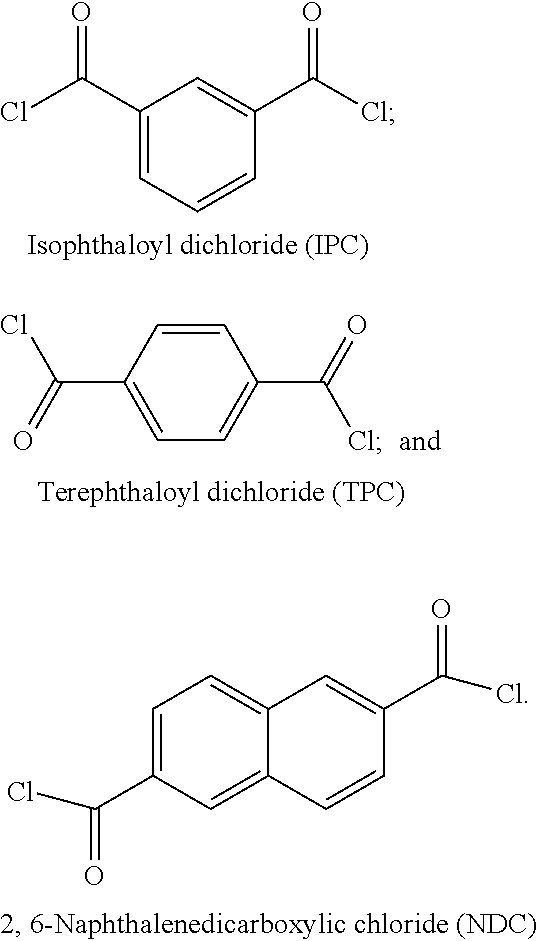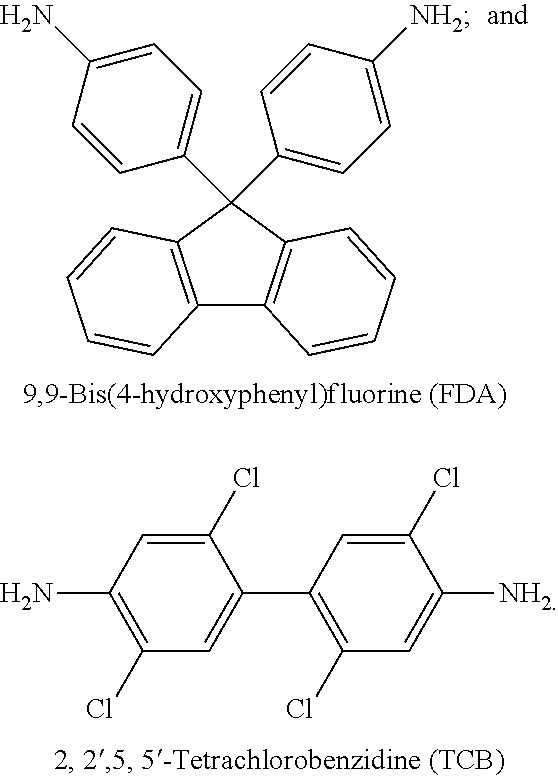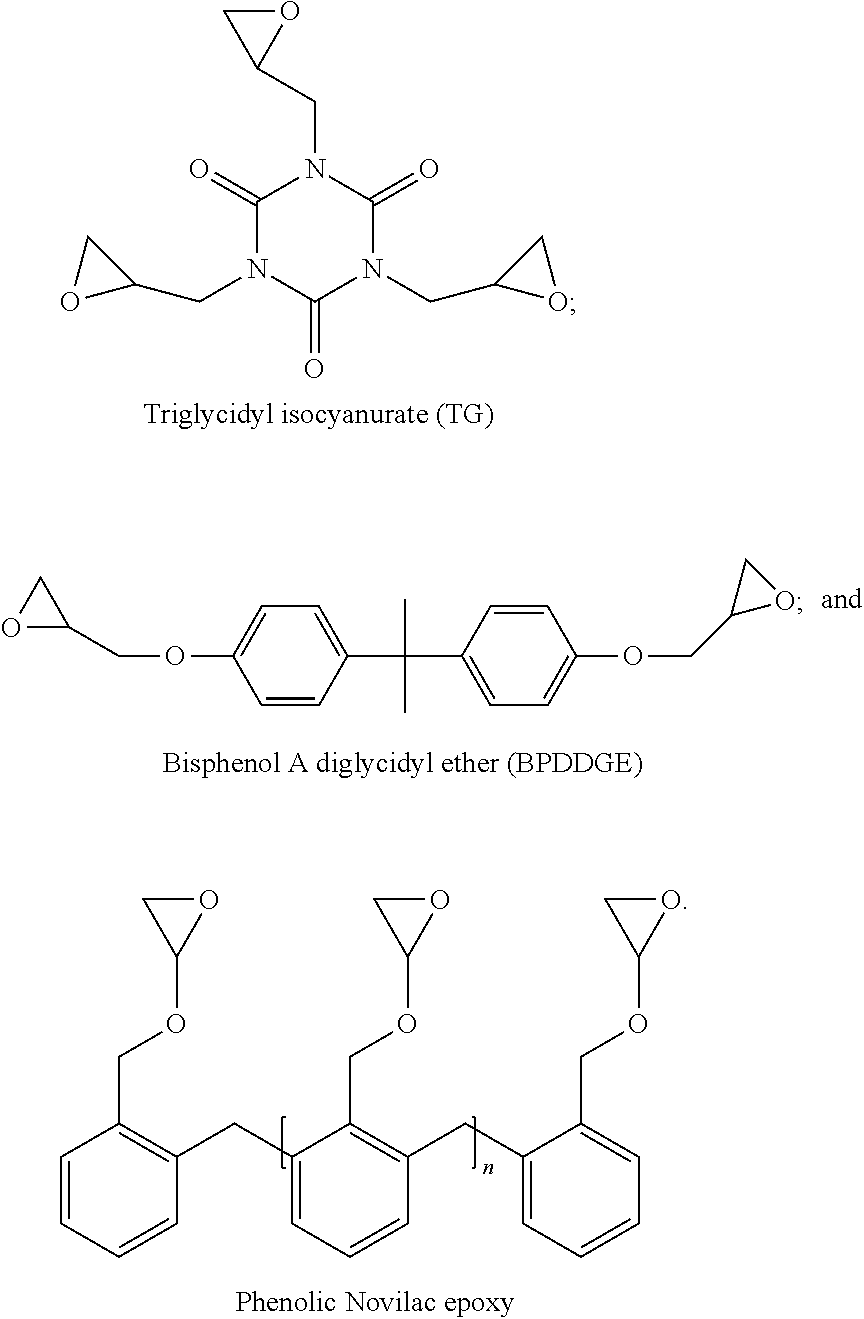Solvent Resistant, Transparent Aromatic Polyamide Films with High Refractive Indices
a technology of aromatic polyamide and solvent resistance, applied in the field of thermal stable aromatic polyamide manufacture, can solve the problems of low tg (150 c), difficult to achieve wide-spread commercial success of such films, and inability to be commercially available, and achieve the effect of high refractive index
- Summary
- Abstract
- Description
- Claims
- Application Information
AI Technical Summary
Benefits of technology
Problems solved by technology
Method used
Image
Examples
example 1
[0021]This example illustrates the general procedure to prepare an aromatic polyamide solution from a mixture of acid dichlorides (TPC, IPC, and / or NDC) and at least one a diamine (FDA or TCB). The general chemical reaction formula is shown below:
[0022]In one experiment, approximately 87.11 g (0.25 mol) of 9,9-bis(4-aminophenyl)fluorine (FDA), 44 g (0.75 mol) propylene oxide (PrO), and 1014 g of dimethylacetamide (DMAc) were added to a 2 L three-necked round bottom flask equipped with a nitrogen inlet and out let and a mechanical stirrer. Once the FDA was totally dissolved, the resulting solution was cooled in an ice-water bath. To the cooled resulting solution, approximately 15.23 g (0.075 mol) of isophthaloyl dichloride (IPC) was added to the flask. Then, approximately 35.53 g (0.175 mol) terephthaloyl dichloride (TPC) was added in several portions over two (2) hours. The dichloride / diamine solution was then allowed to stir at room temperature for another 6 hours to form the polym...
example 2
[0023]This example illustrates the general procedure used to prepare a solution of a polyamide containing pendant carboxylic acid groups. The polymer solution may be made from a mixture of dichlorides (TPC, IPC, and / or NDC) and a mixture of diamines, including at least one with a free pendant carboxylic acid group (FDA or TCB and DAB). The general chemical reaction formula is shown below:
[0024]In one experiment, approximately 3.3101 g (0.0095 mol) FDA, 0.0761 g (0.0005 mol) 3,5-diaminobenzoic acid (DAB), 4.4 g (0.075 mol) (PrO), and 38 g DMAc were added to a 250 ml three necked round bottom flask equipped with a nitrogen inlet and out let and a mechanical stirrer. Once the diamines were completely dissolved, the solution was cooled in an ice-water bath. To the solution, approximately 0.2030g (0.001 mol) of IPC was added to the flask. Then, approximately 1.8272 g (0.009 mol) of TPC was added in several portions over 2 hours. The acid dichlorides / diamine solution was then allowed to s...
examples 3 and 4
[0025]These examples illustrate the general procedure used to prepare polyamide solutions containing multifunctional epoxy compounds (example 3) and multifunctional aromatic carboxylic acids (example 4). Polymer solutions are first prepared as described in Example 1 and then either TG or TA is added (an amount equivalent to 5 wt % of the polymer). The polymer solutions contain a total of about 10 wt % solids.
Preparation of Films
[0026]The polymer solutions are spread on a glass substrate using a doctor blade. The solvent is allowed to evaporate at 60° C. for one hour and the film is then dried at 160° C. under reduced pressure for 12 hours. No further heating is required for films containing multifunctional epoxy compounds. However, films containing multifunctional aromatic carboxylic acids and those prepared from polyamides containing pendant carboxyl groups are further heated at an elevated temperature close to the Tg of the polyamide for 30 minutes and then removed from the glass ...
PUM
| Property | Measurement | Unit |
|---|---|---|
| weight percent | aaaaa | aaaaa |
| temperature | aaaaa | aaaaa |
| refractive index | aaaaa | aaaaa |
Abstract
Description
Claims
Application Information
 Login to View More
Login to View More - R&D
- Intellectual Property
- Life Sciences
- Materials
- Tech Scout
- Unparalleled Data Quality
- Higher Quality Content
- 60% Fewer Hallucinations
Browse by: Latest US Patents, China's latest patents, Technical Efficacy Thesaurus, Application Domain, Technology Topic, Popular Technical Reports.
© 2025 PatSnap. All rights reserved.Legal|Privacy policy|Modern Slavery Act Transparency Statement|Sitemap|About US| Contact US: help@patsnap.com



